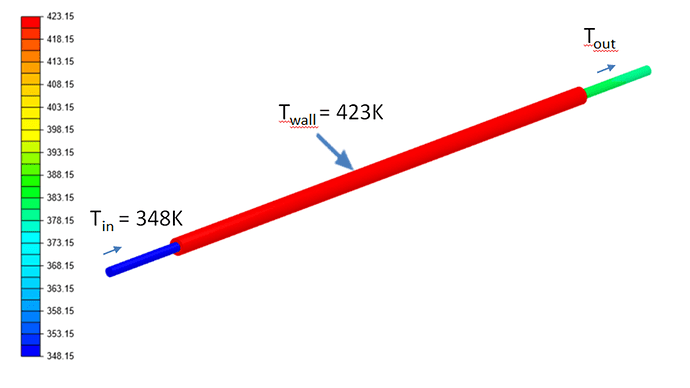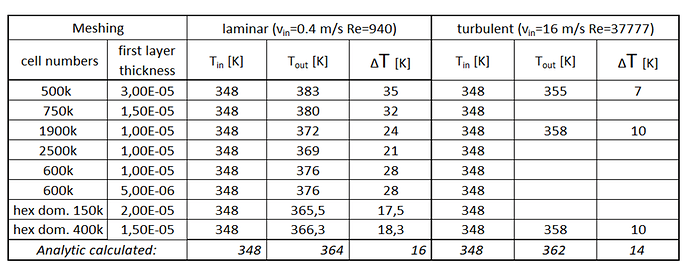Hi, I´m new in SimScale and I’ve done a little experiment which I like to share and discuss.
I’ve done a convergate heat transfer simulation with a very easy geometry like you can see in the picture.
Because of this easy geometry I can calculate the outlet Temperatur without any Simulations. So I know that with an inlet flow of 0.4 m/s (d=0.55mm) the outlet Temperature is around 364K.
Now I wanted to check this result with the simulation result. I get for different meshes different results like you can see in this table.
My questions are:
- are hex dominant meshes better for this simulation?
- how do I know which result is the “right” one if I can’t check it with analytic calculations?
- is the first layer thickness important for the meshing, especially if it is a laminar flow?
I hope this was understandable.
Here is the project:
Greetings
1 Like
Hey @Daniel_Koller,
First and foremost, welcome to the community!
That’s a nice validation project that you got going. When calculating the analytical solution, did you take into account that the flow gains temperature as it goes through the pipe? (i.e. heat transfer varies with temperature gradient)
For your questions:
-
I can see both tet and hex meshes working well for this problem. Since the geometry (and the flow) are quite simple, with a hex mesh you would benefit from the alignment of flow/cell faces. But I’d say you should be able to get good results with either hex or tet;
-
This is a very good question (and to be honest not enough people ask it). What you are doing is totally correct: a CFD project doesn’t consist of a single simulation. You should absolutely test different meshes and different configurations.
The practitioner shouldn’t simply take the first converged simulation and assume it’s 100% correct. Just to give you an example, take a look at the number of runs that this NACA0012 verification project required.
This topic is very broad but the short answer to it would be to follow the best practices and try to estimate the errors of your simulation runs. You can definitely find papers and books on error analysis and estimation in CFD. Just not to leave you hanging, I’ll refer you to Péric & Ferziger - Computational Methods for Fluid Dynamics - Chapter 11: Efficiency and Accuracy Improvement.
-
For turbulent flows, you have to keep in mind the yplus requirements. But regardless of the type of flow, the near-wall-region often times will have bigger gradients and big gradients require more cells to be resolved appropriately.
1 Like
Thank you for your reply.
When calculating the analytic solution, I assumed that the temperature gradient is constant. First I calculated it with a temperature gradient of 75K. Because of your hint I’ve made a second calculation with the average temperature gradient of 67K and get an outlet temperature of 362K (instead of 364K). But these analytic calculations only should gave me a feeling in which area the results will be.

